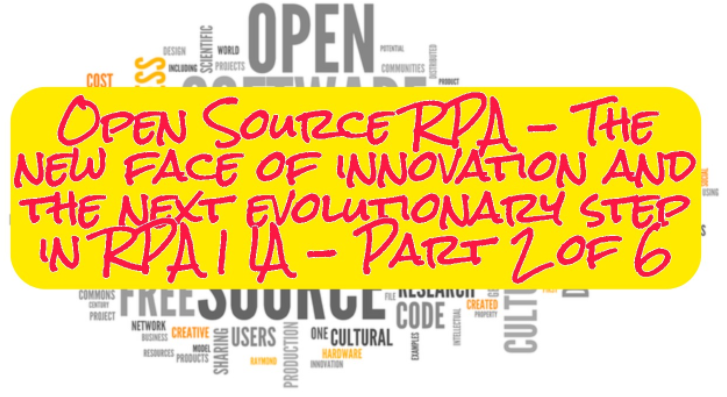40 Essential Selection Criteria to Choose an RPA Platform – Part 1 of 5
RPA is a fantastic tool but it can be complex and expensive. Whatever your vendor tells you, implementing RPA correctly takes considerable time and money.
An automation program within an enterprise of reasonable scale may cost $250k in the first 6 months alone (e.g. software, consultancy, robotics lead, cloud architecture, process mapping software, coders, analysts, etc.). Therefore, selecting your Robotic Process Automation tool should not be a quick decision. Building the right foundations for your digital transformation program is essential to delivering multi-million pounds of long-term business success (i.e. significant investment returns from the automation of processes).
What is Robotic Process Automation (RPA)?
As we discussed in our last article there are many questions you should ask before deciding to invest in RPA in the first place but done right, this is a very worthwhile journey.
Now that your company has decided to invest in RPA you need to select a product that best suits your bold business strategy. Below are the first 8 key criteria that should be considered as you select and score your RPA product or platform be it propriety or off the shelf.
1. Cultural readiness of your organisation – if your organisation is not ready to transform (e.g. it is siloed); is resistant to change; or has IT and business teams that simply won’t ever talk to each other then don’t read any further; stop now and don’t invest in RPA until your solve your people issues.
‘I’ve been banging the drum about this one for years. An RPA programme will only succeed when both IT and Business Operations form a collaborative partnership to deliver the capability. I should know, I have implemented RPA from an IT, Business Operations and Consultancy perspective, and had to deal with the aftermath of IT feeling like the technology has been implemented ‘side of desk’ or forced upon them. Form a trusted partnership rather than having to fix broken relationships further down the line ‘
Allan Surtees, Head of Intelligent Process Automation at Lowell Financial
Alternatively, if you truly believe that the establishment of a co-dependent IT / Operations automation program will bring your organisation together as they deliver on a common goal, then proceed forward at pace.
“Whilst I would always suggest that automating bad processes leads to bad automation, it may in fact be the application of automation that enables a siloed business to become one, by transforming how they are able to communicate and work with one another. If you wait for your culture to change to implement new technology, you’d never change anything”
Edward Halsey, RPA Enterprise Account Manager
2. Strong and active user community – to learn and grow you need an active community from which you can source new learning. RPA has a growing community that is welcoming and open to sharing information but not every RPA product has lots of experienced users.
“Vendors can only scale so far on their own, and this will be driven by a very small subset of factors that they believe will have the biggest impact in the market and with their customers. Active engaged communities are essential for both users and the vendors, as they will naturally fill in the product offering gaps that the vendors are unable to service; be that documentation, tutorials, how to videos, product extensions, or even niche siloed solutions built on top of the vendor platform.
Paul Arnold, Head of Product and Development at Cortex Intelligent Automation
3. Demonstrated capability in delivering for an organisation of your size, industry and complexity – does your system provider have experience of your line of industry with a product that has proven to work in that space or will they be learning with you? Does your vendor software work well with your systems and software?
“We’ve had really good success serving midsize companies because we have a deep understanding of what midsize companies need across the entire RPA customer experience. It’s more than just software – it’s the support, the pricing, all of it matters and has a big impact on the overall success the company has with RPA.”
John Grancarich, Vice President Of Product Strategy
4. Solution durability (low cost of maintenance with a less buggy, more durable system) – how durable is your vendors product? Is it robust, non-buggy and has a 99.999% up time or does it fall over at the slightest opportunity? References and live practice with the product during a POC / POV period will help you understand this.
5. Automation process discovery and mapping tooling – being able to find suitable processes for redesign and automation is one of the most time-consuming tasks in RPA land. Therefore, using a tool to map processes can prove invaluable IF the processes are end-to-end computerised and you are not simply going to replicate the process using RPA without deciding if the process can be stopped or if it can be vastly improved using intelligent automation technology first.
6. Access to skilled talent – there are a variety of ways to get access to skilled RPA talent (e.g. direct hire, system integrator, contract, vendor, etc.). Skilled developers who have real world practical experience are like hen’s teeth (i.e. hard to find). They are both costly to find, train and employ. Ensure your RPA product has a well-stocked supply of affordable market talent otherwise your program may grind to a halt. You may have to train and develop your own talent to succeed, so ensure your vendor has clear learning and certification paths available.
“One of the biggest risks firms make is to underpay their RPA team when others are paying more. Your team will leave and you will have lost your investment in training, platform and process knowledge. You will then have to invest in training new people once again. Pay what you need to pay to reap the rewards.”
Gavin Price, RPA Jedi
Alternatively, if a code-based, IT lead, approach simply won’t work in your organisation then move rapidly toward a low-code software solution.
“There is a growing trend for all kinds of solutions to reduce the amount of coding required as much as possible. RPA is no exception. This is probably a reaction to customers’ fears about large ongoing costs and having to re-train people to use specialised technical equipment. Low- and no-code solutions offer can be used more intuitively and without the intervention of the IT department which makes them much faster to implement. RPA is adding in AI and voice recognition, so the days of asking the computer to do something may soon be upon us – perhaps faster than you think.”
Ian Hawkins, Editor, PEX Network
Low-code application development software gives non-programming, tech-savvy business user, the ability to visually build out applications. An in-house, citizen-developer lead approach can help ensure that end users rapidly build out the functionality they need to succeed.
‘What if you didn’t need developers at all, but business users could be empowered to build complex automations through drag-and-drop interfaces and recorders, supported by accredited learning?’
Edward Halsey, RPA Enterprise Account Manager
7. Coding language and product extensibility – an RPA product should include a lot of ‘out of the box’ functionality, but you will still need to amend the vendor supplied code objects to better allow you to meet your specific business needs.
Different vendors allow more or less access to their code and operate using different code languages e.g. c#, VBA, python etc. Look behind the scenes to ensure you can amend the code and that the coders required are both plentiful and affordable in your market otherwise this is a hidden cost you will discover at some point in time that can make your business case fall over.
“Many RPA tools allow custom code injections and very often it’s a great way to ensure that your automations are precisely suited to your business’ needs. Do not be afraid of extending the default functionalities of your tool of choice.”
Jan Mastalski, Lead RPA Developer at innogy
8. Attended, unattended, hybrid automation capabilities – RPA products offer come in a variety of flavours from which to pick. You need to decide whether attended, unattended or hybrid is right for your organisation and score accordingly. Choose carefully and resist the temptation to ignore an unattended automation product that might be better suited to your needs ‘just in case’ things change later. Unattended automation products can be extended to become more like attended products with 3rd party tools or clever coding and robot monitoring.
“Understand that different RPA tools are better for different purposes. Many of the large RPA vendors are well suited to unattended automation in back-office environments. Most will also claim to have some kind of attended automation solution as well – although interpretation of what is meant by attended automation can differ within the market. However, think carefully about selecting a tool to operate in a truly real-time setting e.g. a call centre. Whilst some forms of attended automation might be suitable for some call-centre type operations, you may be better suited exploring options with specialist automation offerings focused on call centres.”
Darren Mee, Partner & Management Consulting Lead
Selecting the right RPA tool or indeed intelligent automation tools is key to the success of your RPA journey. Get your tool selection right and you give yourself every chance of success. Get your tool of choice wrong and your costly business error may result in a loss of money and indeed your job.
What do you consider to be the most important criteria for selecting an RPA product?
This article is part of a #RebootRPA series. #RebootRPA is a series of articles written by real world experts to help you overcome the challenges of selecting, implementing and scaling an RPA platform.
- RPA Reboot: RPA 101
- The A-Z of Robotic Process Automation, Intelligent Automation and Digital Transformation
- 8 Key Roles in Your RPA Centre of Expertise
- 14 rules for Robotic Process Automation (RPA) and Intelligent Automation (AI) success
- If you are not willing to go all in, then don’t put on your RPA swimsuit.
- The biggest lie told to RPA customers – 50 robots equals success
- 40 essential selection criteria to choose an RPA platform part 1 of 5
- 40 essential selection criteria to choose an RPA platform part 2 of 5
- 40 essential selection criteria to choose an RPA platform part 3 of 5
- 40 essential selection criteria to choose an RPA platform part 4 of 5
- 40 essential selection criteria to choose an RPA platform part 5 of 5
Tag and share: If this could benefit someone else tag them and share this.
Free to reuse: If you think this article would be beneficial to others; please do feel free to share it. If you want to post this article on your LinkedIn page, then please feel free to do so. The more information we share within the RPA community the more likely businesses are to succeed with this excellent technology.
Further Help: If I can help you in any way please do reach out.
Note: The views expressed above are my views and not those of my employer.







Leave a Reply